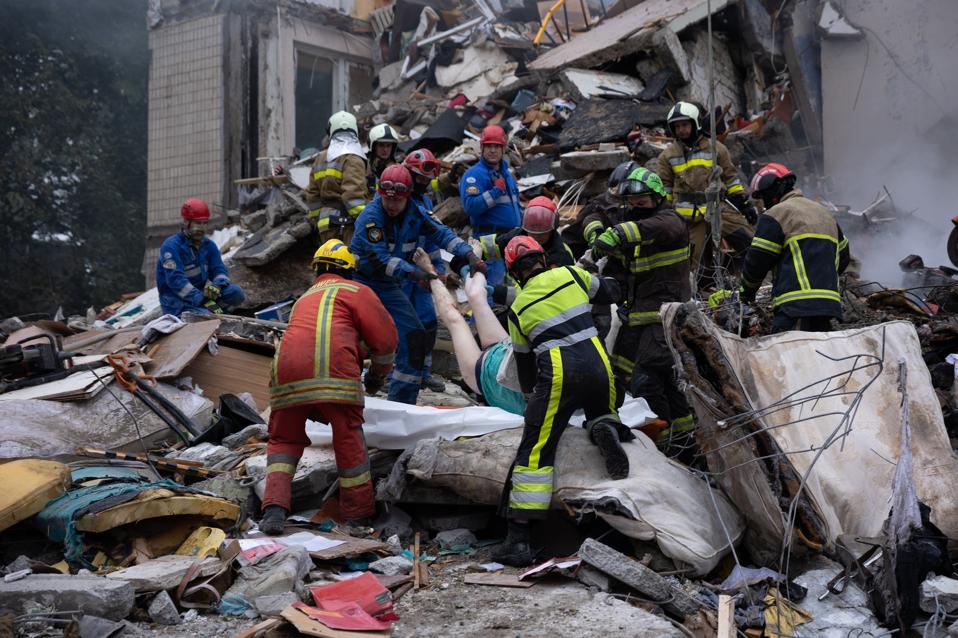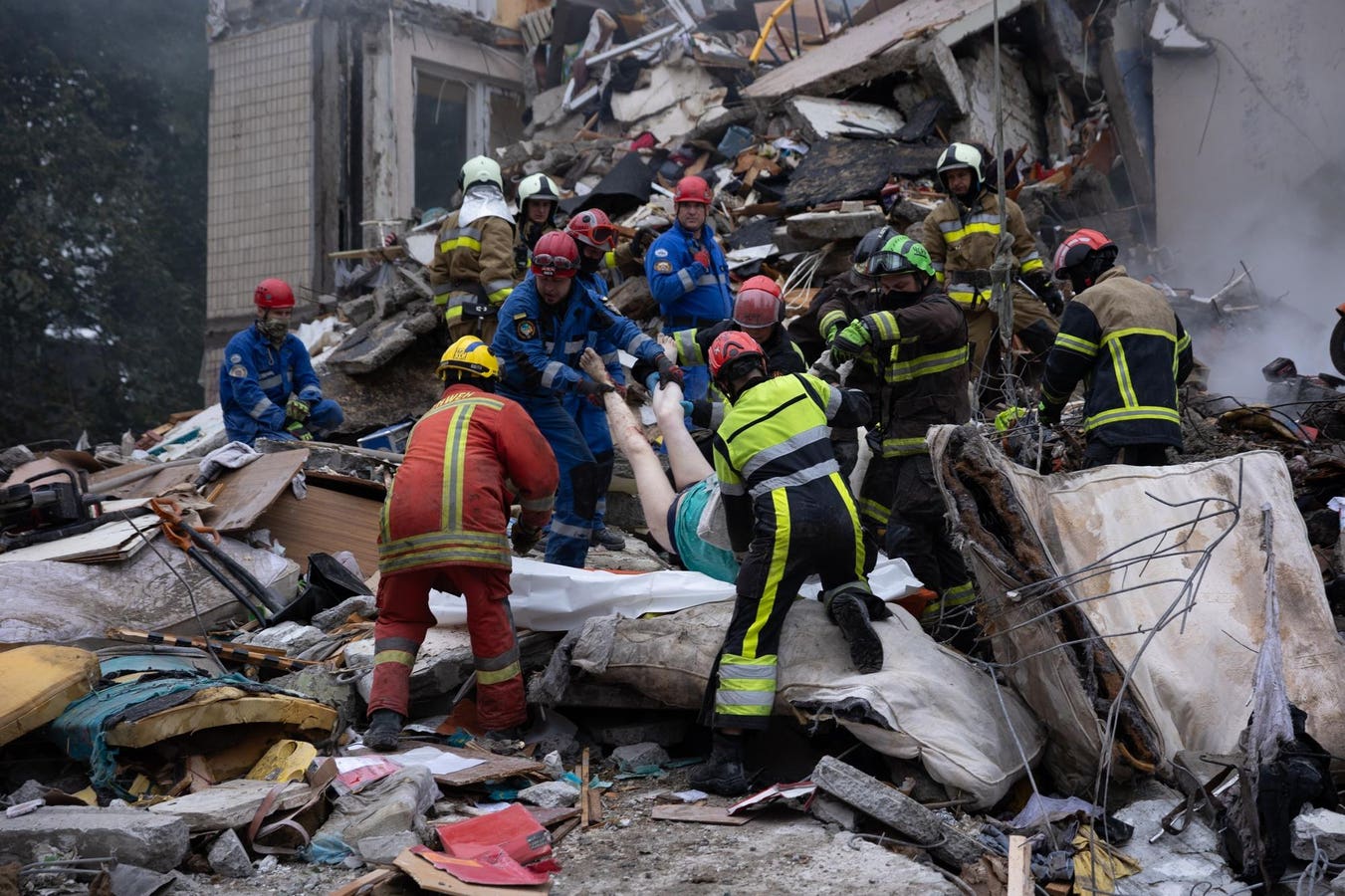
KYIV, UKRAINE – JULY 31: Rescuers put dead person into white body bag from partially destroyed residential building after Russian drone-and-missile attack on July 31, 2025 in Kyiv, Ukraine. Photo by Oleksandr Magula/Suspilne Ukraine/JSC “UA:PBC”/Global Images Ukraine via Getty Images
Global Images Ukraine via Getty Images
Dispatches from Ukraine. Day 1,254.
Russian Attacks on Ukraine
Early on July 31, Ukraine’s Air Force intercepted and electronically neutralized 208 drones and three cruise missiles; nevertheless, five missiles and 21 drones struck targets at 12 locations. The attack primarily targeted Kyiv, where a Russian missile reduced a residential building to rubble, resulting in at least 15 deaths as well as wounding more than 145 inhabitants, including 14 children. Mayor Vitaliy Klitschko declared August 1 a day of mourning in remembrance of the victims.
Three of the Kremlin’s most intense, large-scale aerial attacks to date occurred this July. Throughout the month, Russia bombarded Ukraine with 6,495 drones and missiles, more than one-fifth of all projectiles launched this year. Russian attacks waned toward the end of the month, culminating in a final series of strikes of 200-300 projectiles. Still, the average daily number of aerial weapons dispatched amounted to 210 units, a 10% increase compared to June.
In stark contrast to last summer, when Moscow could deploy only a few dozen drones overnight, the scale of its current operations has escalated dramatically. As of last September, Forbes Ukraine estimated Russia’s drone production to be approximately 500 units per month; currently, the Ukrainian government estimates Russian production at 170 drones daily, with ambitions to accelerate to 190 units.
Russia has improved not just the quantity of its drones but the quality as well. During the latest aerial attacks on Ukraine, Moscow started deploying a new class of drones: jet-powered Shaheds. Unlike propeller-driven drones, they are outfitted with compact turbojet engines. This technological modification enables speeds exceeding 310 miles per hour and flight ranges up to 1,500 miles.
Ukrainian military analysts note that these drones are harder to intercept. For low-altitude interceptors and mobile fire teams, they might be virtually unstoppable. Protection against such advanced drones might require more sophisticated radar-guided air defense platforms or even fighter jets. Although Russian’s use of jet-powered Shaheds has been limited so far, Ukrainian officials view their appearance as a threat to the country and a likely strain on air defenses in the long term.
Smaller-scale Russian daytime strikes across Ukraine killed at least 35 civilians and wounded more than 150 from July 29 to July 31. In the southeastern Zaporizhzhia region, a Russian glide bomb attack on a local penitentiary killed 17 inmates and wounded more than 80 others in one of the deadliest strikes in the region to date. Russian shelling and drone attacks in the northeastern Kharkiv region killed nine people and wounded 16 others. In the neighboring central Dnipropetrovsk province, Russian forces killed five civilians and wounded another 32. In eastern Donetsk region, sustained shelling killed three civilians and wounded 19 others; on the Ukrainian-controlled right bank of southern Kherson province, drones killed one civilian and wounded nine others.
President Trump Pushes for Negotiating Ceasefire by August 8
Speaking to the UN Security Council, senior U.S. diplomat John Kelley said that U.S. President Donald Trump wants to end the war in Ukraine by August 8. “Both Russia and Ukraine must negotiate a ceasefire and durable peace….The United States is prepared to implement additional measures to secure peace,” he said. His statement followed President Trump’s warning on July 28 that the U.S. would begin imposing tariffs on Russia if progress toward peace weren’t made within 10 days.
The day after President Trump’s renewed ultimatum, Kremlin spokesperson Dmitry Peskov said that although Russia continues to monitor Trump’s statements on sanctions against Moscow, it has “developed immunity” to such measures after years under Western sanctions. “We have been living under a huge number of sanctions for quite a long time….Our economy operates under a huge number of restrictions,” he said.
If the Kremlin does not agree to a ceasefire by August 8, it will mark the first time that it has disregarded a firm deadline publicly set by Trump for ending the war. Until now, he has avoided specific deadlines, instead opting for open-ended language and communicating the dates only through close senior U.S. officials.
Ukraine Restores Anti-Corruption Agencies’ Power
On July 31, Ukrainian President Volodymyr Zelenskyy signed a new law that restores the independence of the country’s anti-corruption agencies. Adoption of the law followed the first wartime protests and unexpectedly sharp criticism from Western allies, particularly European partners. Just nine days earlier, on July 22, the administration had pushed through a controversial law making the country’s anti-corruption agencies dependent on the General Prosecutor, a direct presidential appointee.
The European Commission welcomed Ukraine’s legislative reversal. Brussels, however, made it clear that the work is far from over for Ukraine. “This is not the end of the process,” European Commission spokesperson Guillaume Mercier stressed. He also confirmed that the EU has no plans to freeze financial assistance to Ukraine after the new law is passed. “I can confirm there are no plans to suspend EU funding,” Mercier told Ukrainian media outlet European Pravda. The EU previously had suspended $1.7 billion of financial assistance to Ukraine due to Kyiv’s failure to deliver on promised reforms.
By Danylo Nosov, Alan Sacks

